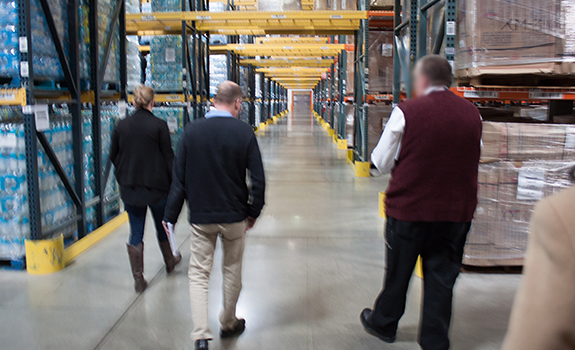Peter Tyler
Author

Earlier this month, Project On Government Oversight staff toured a major Federal Emergency Management Agency (FEMA) supply center in Frederick, Maryland. The visit provided important insights into the nation’s ability to respond to disasters. It also provides an example for how the federal government can and should quicken its lifesaving responses.
A series of major storms and other natural disasters struck the United States less than seven months ago, resulting in loss of life, widespread suffering, and record-setting damage totaling in the tens of billions of dollars. The communities in large areas of the United States are still recovering. In fact, officials do not expect Puerto Rico to have full restoration of electric power until May—shortly before the 2018 hurricane season officially starts on June 1.
POGO has written about the new normal, where major disasters occur regularly and with more devastating impacts. According to the National Oceanic and Atmospheric Administration, which tracks the cost of U.S. weather-related disasters, the trend of greater and costlier damage is clear. 2017 tied with 2011 for the highest number of billion-dollar hurricane disasters. The four 2017 hurricanes that made U.S. landfall—Harvey, Irma, Maria, and Nate—set a new single-year record by causing more than $265 billion in damages. Looking more long-term, the average number of such billion-dollar disasters has doubled since 1980. Most importantly, these disasters result in loss of life and suffering within the affected communities that is impossible to quantify in dollar amounts, but must remain a major consideration.
The United States government needs to up its game in preparing for the inevitable next major hurricane, earthquake, wildfire, or other disaster threat.
A critical element of disaster response is the network of disaster supply warehouses operated by the Federal Emergency Management Agency. The agency maintains a series of eight warehouses of supplies in the United States, ready for delivery before a disaster strikes.

On March 9th, POGO staff visited the FEMA commodity distribution facility in Frederick. The large and modern facility is located about 50 miles from Washington, DC, and only an hour or two by truck from the Baltimore and Philadelphia harbors. FEMA allowed our staff to walk through the facility, and explained how the agency prepares for disasters by maintaining stocks of key supplies and then distributing them during a time of disaster.

There is a lot of stuff. A walk through the warehouse showed large shelves stocked with pallets of supplies for disaster response: More than a million liters of bottled water; two million meals; blankets; cots; plastic tarps; and baby kits containing diapers and formula, all plastic-wrapped and ready for shipment. The supplies are well-marked, including with expiration dates, shipping weight, and inventory codes. Supplies nearing expiration are regularly noted and replaced with fresh inventory. FEMA donates the items nearing expiration to non-profit charities, such as food banks.
Altogether, the combined network of FEMA commodity centers is expected to supply 1.75 million people for five days after a disaster strikes. If there is advanced notice of a pending disaster, such as a hurricane, supplies are transported closer to the expected location of landfall. After a disaster has struck, FEMA coordinates the work of all of its commodity centers to begin shipping supplies.
The ability to supply 1.75 million people for five days provides critical support to disaster survivors. However, last summer’s hurricanes showed that FEMA needs to substantially increase its capacity to respond. The number of people in Puerto Rico affected by hurricane Maria was huge, with more than a million people lacking access to running water and 3 million without power one month after the storm. And that was just after hurricanes struck Florida, Texas, the Virgin Islands and other communities affecting millions more.
It is much more efficient and less expensive to have supplies on hand before a disaster strikes, as opposed to rushing for supplies after the fact. Having supplies on hand also provides more options for speedy delivery in order to save lives and reduce suffering. Interestingly, one of the eight regional commodity centers is located near San Juan, Puerto Rico. However, FEMA officials noted that the facility was not able to restock quickly enough between the hurricanes that struck the U.S. territories in the Caribbean, underscoring the importance of the FEMA warehouses having adequate levels of supplies.
Immediately after the disasters, FEMA started contracting for additional quantities of supplies. However, this approach did not always prove successful. For example, contracts for both meals and tarps ended in cancellation after companies were unable to deliver.

Clearly, the amount of supplies ready for use at the commodity centers is dependent on how much FEMA can spend for them. The current budget for the commodity programs? A report by the Government Accountability Office states that FEMA spent roughly $65 million in fiscal year 2014 for salaries and operating expenses at the commodity centers. Considering the increasing need due to the trends in U.S. disasters, this is no longer adequate. FEMA and the Administration should increase the required target levels of support for disaster victims and Congress should appropriate increase funding for stored supplies in the commodity warehouses.
According to officials who briefed the POGO staff, FEMA and the Administration are currently reviewing lessons learned from the 2017 disaster response. Will FEMA and the Administration change the disaster commodity requirements to reflect the new normal of larger and more damaging disasters? Perhaps. An announcement is expected in the coming weeks.

Sent Saturdays
